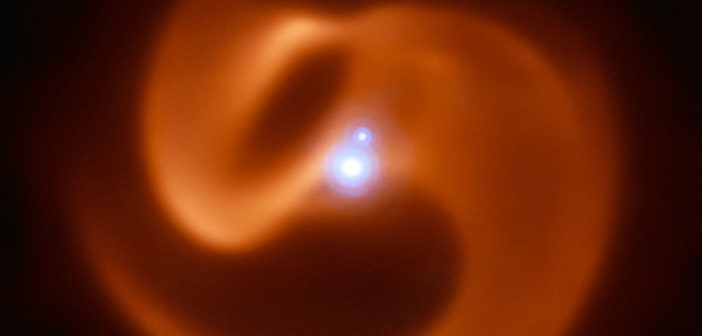
False-color infrared image of a pinwheel-shaped dust spiral around a dramatic evolved binary star. A new study has found a similar pinwheel — but with some surprising differences. [ESO/Callingham et al.]
Spiral galaxies are one thing — but some spiral patterns in the sky are created much closer to home, arising from stars instead! A recent study explores a stellar pinwheel spotted around an unexpected source.
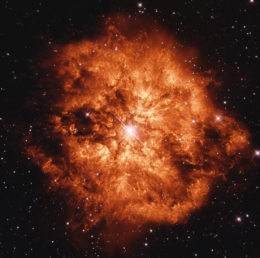
The powerful winds of a lone Wolf-Rayet star — like WR 124, seen in this actual Hubble image — can inflate a stunning nebula as the star loses mass. [ESA/Hubble & NASA / Judy Schmidt]
Monster Stars
Even on the already dramatic scale of massive, evolved stars, Wolf-Rayet stars are extreme.
These monsters are in the final stages of their evolution, doomed to end their lives soon as violent supernovae. Until then, Wolf-Rayet stars are here for us to observe: scalding hot — with surface temperatures that range from 30,000 K to 210,000 K — and enthusiastically shedding mass via powerful stellar winds that can reach speeds of up to 3,000 km/s (that’s 6.7 million miles per hour).
Putting on a Show
Wolf-Rayet stars can create quite the spectacle, generating stunning nebulae even when isolated. But put them in a binary pair with another hot, massive star? Then you get something else entirely. In particular, scientists have found multiple examples of Wolf-Rayet binaries producing astonishing spiral pinwheel patterns of dust, visible in the infrared.
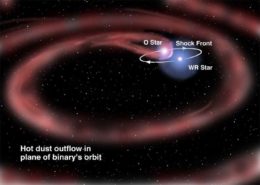
Schematic showing the formation of a spiral around a binary consisting of a massive star and a Wolf-Rayet star, both emitting powerful stellar winds. Click to enlarge. [Gemini Observatory/Jon Lomberg]
How does this work? Where the strong winds of the Wolf-Rayet star and its massive companion collide, a plume of dense gas and dust is produced that gets carried outward with the Wolf-Rayet wind. As the pair of stars orbits, the dust plume forms an ever-expanding spiral extending from the binary.
Pinwheels Tied to Type?
Wolf-Rayet stars are identifiable by characteristic broad emission lines. From their spectra, these stars can be classified into two main subcategories: those with strong carbon and helium lines (WC subtype) and those with strong nitrogen and helium lines (WN subtype).
Infrared pinwheel structures have only ever been spotted around binaries that contain WC-subtype stars — likely because WC winds facilitate infrared-emitting dust formation in the shocked region where the Wolf-Rayet winds collide with those of its binary companion, whereas WN winds do not.
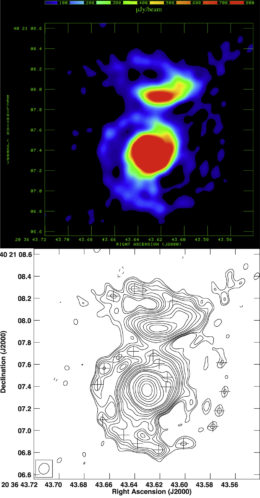
The top panel shows a false-color radio image of WR 147, captured with the Jansky Very Large Array. Can’t make out the spiral? Check out the bottom panel, which is the same image as a contour map, with the pinwheel marked by crosses. The binary lies at the heart of the spiral; the source of emission above the binary is due to an additional, distant stellar companion forming a triple system. [Adapted from Rodríguez et al. 2020]
But now, a team of scientists led by Luis Rodríguez (UNAM Radio Astronomy and Astrophysics Institute; Autonomous University of Chiapas, Mexico) has found an example of a WN-subtype star that’s also created a pinwheel: WR 147. The catch? The pinwheel isn’t visible in infrared; in fact, we can only see it at radio wavelengths.
A Different Emission Mechanism
What’s going on with WR 147? This star is still emitting strong stellar winds that collide with the winds of its companion — but because of its WN subtype, it doesn’t form a dust plume at the collision point. Nonetheless, particles are still being accelerated in the collision zone, and they emit synchrotron radiation, a type of radio emission caused by particles spiraling around magnetic field lines.
Thus, WN-subtype Wolf-Rayet stars can still form pinwheels — we just have to look at radio observations of the systems rather than infrared in order to spot them. This discovery opens the door to significant further exploration of these systems, providing us with the opportunity to probe orbital periods, wind speeds, wind-momentum ratios, and more. You can bet we’ll be looking for more of these spirals in the sky in the future!
By Susanna Kohler (AAS Nova)
Original Story:
[AAS Nova] A Stellar Pinwheel at a New Wavelength
Scientific Paper:
“A Radio Pinwheel Emanating from WR 147,” Luis F. Rodríguez et al. 2020 ApJL 900 L3. doi:10.3847/2041-8213/abad9d


